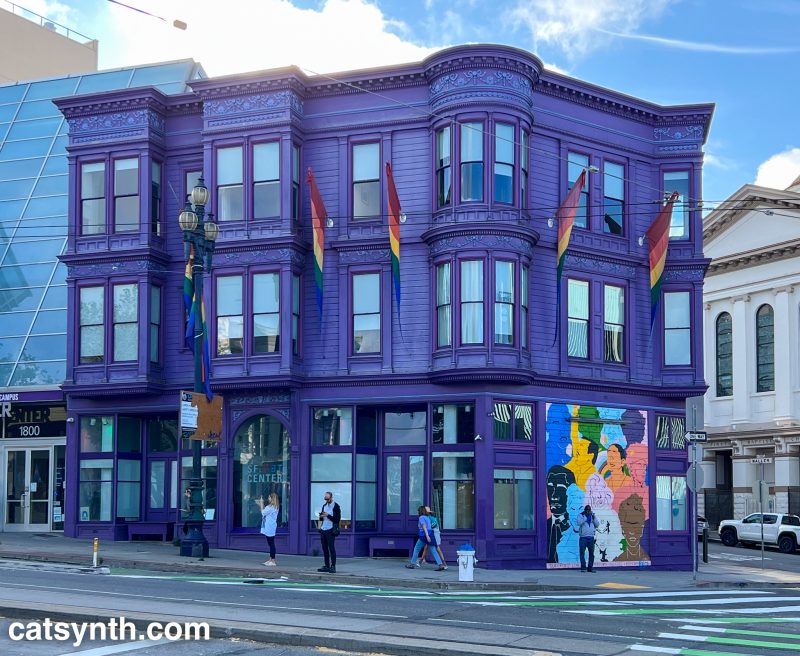
Bright purple building at the intersection of Market Street and Waller Street in San Franciso. It just so happens to be the SF LGBT Center, all decked out for Pride.


Bright purple building at the intersection of Market Street and Waller Street in San Franciso. It just so happens to be the SF LGBT Center, all decked out for Pride.
This past Thursday, the Center for New Music launched Compton’s Cafeteria Series, a set of occasional concerts featuring transgender performers. And I was there both the cover the show and be a part of it!
For those who are not familiar with the story, Gene Compton’s Cafeteria was a small restaurant chain and its Tenderloin location at the corner of Taylor and Turk Streets was one of the few places where transgender individuals, and especially transgender women, could safely congregate. There was, however, some tension between transgender patrons and the staff, who often called the police, with arrests and harassment ensuing. In 1966, this pattern led to the Compton’s Cafeteria Riots.
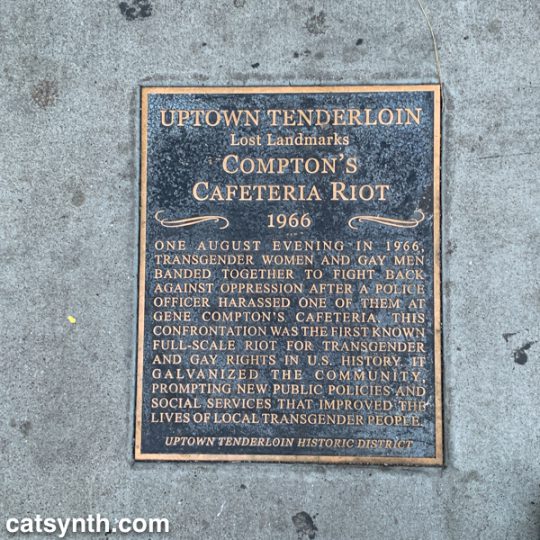
In the 1960s the Compton’s Cafeteria staff began to call the police to crack down on transgender individuals, who would frequent the restaurant.[8]Management felt that transgender customers were loitering and causing them to lose more desirable business. In response, they implemented a service fee directed at transgender individuals and blatantly harassed them in an attempt to get them to leave the restaurant.[8] In response to police arrests, the transgender community launched a picket of Compton’s Cafeteria.[9] Although the picket was unsuccessful, it was one of the first demonstrations against police violence directed towards transgender people in San Francisco.[9] On the first night of the riot, the management of Compton’s called the police when some transgender customers became raucous. Police officers were known to mistreat transgender people.[10]When one of these known officers attempted to arrest one of the trans women, she threw her coffee in his face.[2] According to the director of Screaming Queens, Susan Stryker, the cafeteria “erupted.”[5]
https://en.wikipedia.org/wiki/Compton%27s_Cafeteria_riot
This was nearly three years before the Stonewall Inn Riots in New York but has not gotten nearly the visibility in the time since. There is a plaque on the sidewalk in front of the former site at 101 Turk Street, and there is now an honorary street renaming of the 100 block of Taylor Street as Gene Compton’s Cafeteria Way – we featured the sign in our most recent Wordless Wednesday post.
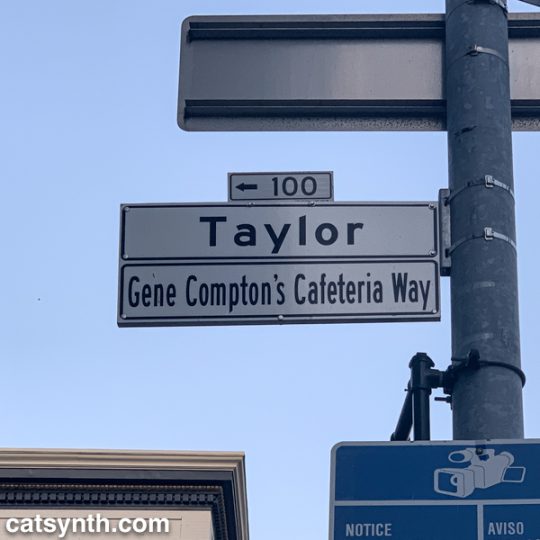
More importantly, the immediate vicinity has been recognized by the city as a “Transgender Cultural District.” As the Center for New Music is located in the heart of this new district, it seemed natural for them to host a series celebrating transgender visibility (and audibility), and I am grateful to the staff there and to my friend David Samas for proposing this and making it happen.
The show itself was a successful event featuring vary different performances, although they all made extensive use of hardware synthesizers. You can see some of the highlights in my latest video.
The evening started with a set by Rusty Sunsets (aka Cara Esten). Her performance was divided into two sections, the first featuring acoustic guitar and voice, and the second incorporating synthesizers and drum machines. Both parts were unified by Esten’s folk-song style, with a series of compositions about her upbringing in Oklahoma and loves lost and found. Perhaps the poignant was a love song inspired by the 1911 Triangle Factory fire in New York where 146 workers, the vast majority of whom were women, perished. My favorite was the final song which brought together a Moog Mother-32 and other synthesizers with plaintive but optimistic singing.
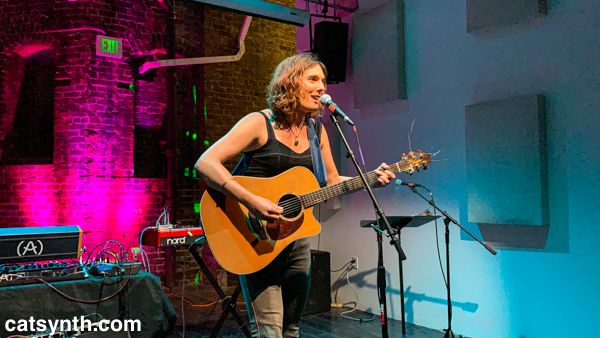
Next up was Pitta of the Mind (Amanda Chaudhary and Maw Shein Win). We performed a short set with a featured color of blue – set against the fuschia background lighting and my automated multicolor blinking lights. Musically, it had a very punctuated quality with abstract sounds from the modular and Arturia MicroFreak against some of Maw’s poems that featured open space and short lines. We mixed it up for the final piece, which had lusher and more emotive quality with longer lines and acoustic piano – these pieces are a strength for us and we always include at least one.
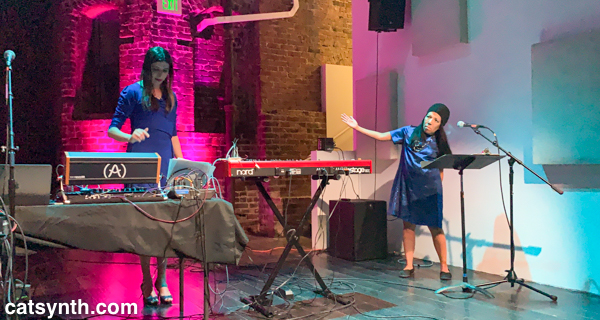
Then it was time for the final set, featuring my solo electronic performance. I started with the solo version of White Wine (and a cup of white wine). The Casio SK-1 was sampled and remixed in Ableton Live, with the statement of the melody and cords, followed by a cacophony leading into two distinct rhythmic sections: first a funk/disco sound featuring MicroFreak bass and a jazz piano improvisation; and then a Stereolab inspired electric-organ solo leading into a final section of tape-delayed metallic sounds (Strymon Magneto and Pocket Gamelan from Crank Sturgeon).

After that, it was on to the cat-infused and disco-and-French-House inspired Donershtik. The piece is just a lot of fun, a classic 70s analog melody (in this case on the Arturia MiniBrute) in Phrygian mode followed by playful modular improvisation (anchored by the MOK Wavewazor) going into the electric piano disco/house section.
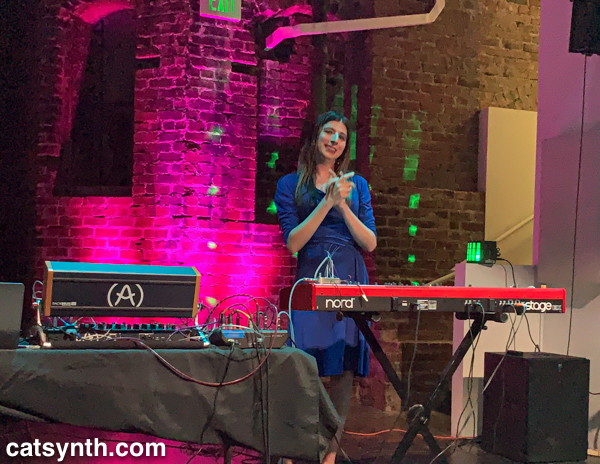
Overall, I think this was one of the best of my live solo sets, tightly choreographed with a relatively diverse and robust setup, and well-defined and well-rehearsed pieces. Once again, structure and hard work paid off.
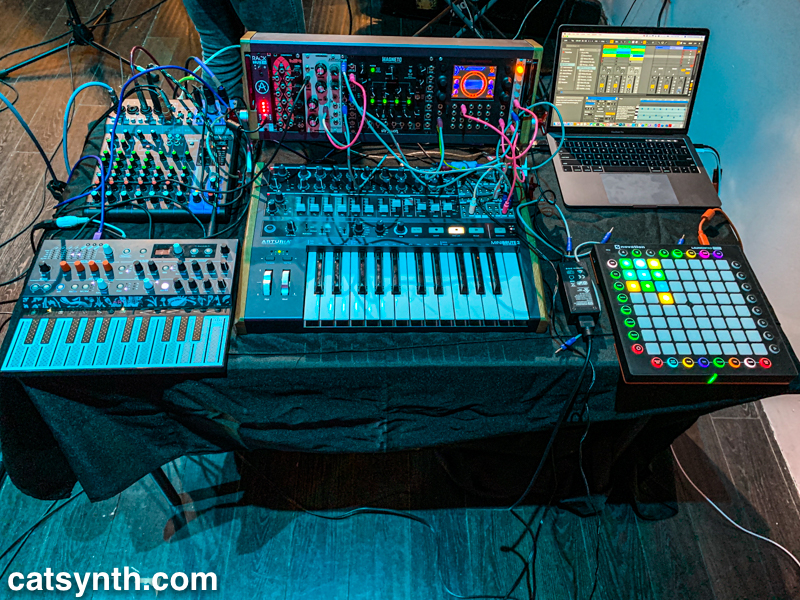
But I also fed off the positive energy and enthusiasm of the crowd, which brought together regular friends and fans with members of the transgender community. It was a beautiful night overall, and I look forward to both being present and helping organize the next in this series.
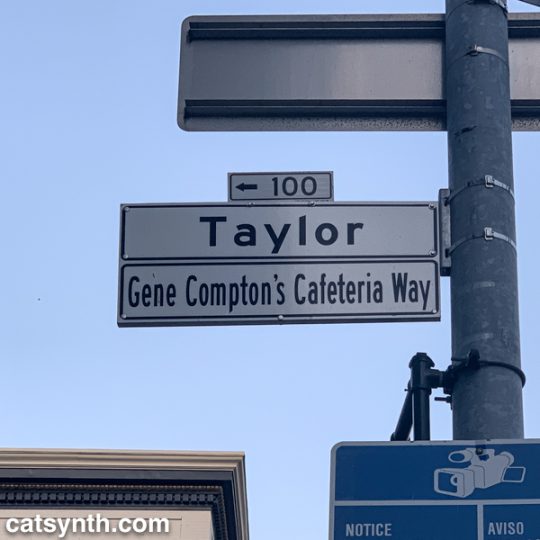
In 2016, the 100 block of Taylor Street (between Turk and Eddy) was designated as Gene Compton’s Cafeteria Way for the 50th anniversary of the Compton Cafeteria Riots, a riot and protest by transgender people, drag queens, and others two years before the famous Stonewall Inn Riot in New York. I happened to be at the unveiling during Pride 2016 and can read my report here.
The Center For New Music, which is half a block north on Taylor Street, is launching a series commemorating its famous neighbor and transgender awareness and activism. I am proud to be one of the inaugural performers: you can find more about the show this Thursday here.
Finally, you can also read my article about walking the entire length of Taylor Street.
The West Village is an odd place. Streets cross one another at odd angles, leading to situations where numbered streets intersect, and small triangular slivers of park space emerge. One such location is the park where Christopher Street, Grove Street, West 4th, and 7th Avenue all meet.

It’s a sliver of a park, but it includes the Christopher Street subway stop for the 1 IRT, a stop I have found most useful in recent years. And this angular collision of roads also has another significance.
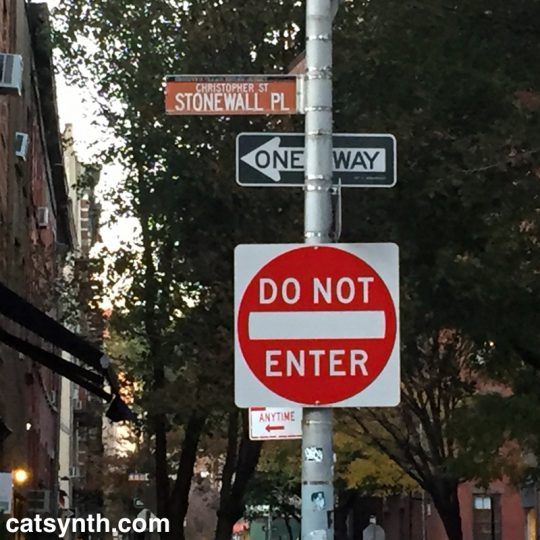
On the northern side of Christopher Street is the Stonewall Inn. The riots 50 years ago turned from a notorious Mafia-run bar for the most outcast members of the queer community to perhaps the sacred site in the world for the LGBTQ community and members of sexual minorities.
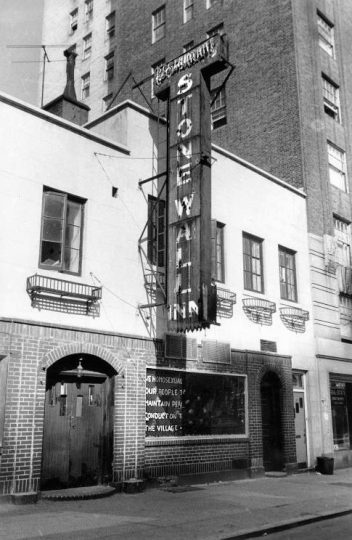
As people converge on lower Manhattan for New York Pride and World Pride – and we gather ourselves here in San Francisco, it’s worth looking back at what happened 50 years ago.
The age of the clientele ranged between the upper teens and early thirties, and the racial mix was evenly distributed among white, black, and Hispanic patrons.[57][59] Because of its even mix of people, its location, and the attraction of dancing, the Stonewall Inn was known by many as “the gay bar in the city”.[60] Police raids on gay bars were frequent—occurring on average once a month for each bar. Many bars kept extra liquor in a secret panel behind the bar, or in a car down the block, to facilitate resuming business as quickly as possible if alcohol was seized.[8][10] Bar management usually knew about raids beforehand due to police tip-offs, and raids occurred early enough in the evening that business could commence after the police had finished.[61] During a typical raid, the lights were turned on, and customers were lined up and their identification cards checked. Those without identification or dressed in full drag were arrested; others were allowed to leave. Some of the men, including those in drag, used their draft cards as identification. Women were required to wear three pieces of feminine clothing, and would be arrested if found not wearing them. Employees and management of the bars were also typically arrested.[61] The period immediately before June 28, 1969, was marked by frequent raids of local bars—including a raid at the Stonewall Inn on the Tuesday before the riots[62]—and the closing of the Checkerboard, the Tele-Star, and two other clubs in Greenwich Village.[63][64]
https://en.wikipedia.org/wiki/Stonewall_riots#Stonewall_Inn
What is notable is what the offenses were. The issues were not so much sexual practices as traditional gender norms. Women without at least three pieces of feminine clothing, men in drag were the targets. And khas vishalom they might even be dancing! It was all about control and conformity. I look back at it with a mixture of bewilderment, pity, disgust, and even contempt for people who were frightened and upset by these behaviors that they would criminalize it violently. And lest we get too smug, violence continues to this date in the United States, most notably the murders transgender women of color. And the attack on conformity is something to be celebrated rather than resisted – indeed that was part of what attracted to this world decades before I knew that I myself was a member of its motley lot.
Many are using the occasion of the 50th anniversary to remind everyone that Stonewall was a riot, a moment of fighting back, rather than simply a large parade. But the parades and celebrations are great, too, as a reminder of what has changed. Indeed, one of the most criticized elements of Pride in this decade of the 21st century is just how commercial and “corporate” it has become. Sure, it’s tacky at times and easy to be cynical about some corporations’ motives. But the point is that mainstream businesses want to be seen as being on the side of the LGBTQ community, the “right” side, and the “profitable” side. One day it will be those who were so frightened by and bothered by these expressions of love and individual identity that they must respond with violence and law who will be pushed to the margins. And push them we shall, but it a way that still preserves their dignity and individuality, lest we end up making similar mistakes.

The map is a bit misleading, because it also should include Alaska, Hawaii, the Commonwealth of Puerto Rico, and the territories. But this is a great day no matter how one looks at it. Today’s Supreme Court decision ends this particular battle and its sometimes baffling legal opposition once and for all.
The hashtag #LoveWins does feel like a bit of a cop-out in terms of the profundity of this moment. Some of the fears of the opposition are what make it momentous – we stared down traditional mores and prejudices and powerful social and religious institutions and won! But at the same time the decision and result just affirms them. Anyone who has been to a same sex wedding (at least in the U.S.) knows that it differs not at all from the variety of customs in opposite-sex weddings.
The already famous lines from today’s ruling:
No union is more profound than marriage, for it embodies the highest ideals of love, fidelity, devotion, sacrifice, and family…In forming a marital union, two people become something greater than once they were. As some of the petitioners in these cases demonstrate, marriage embodies a love that may endure even past death. It would misunderstand these men and women to say they disrespect the idea of marriage. Their plea is that they do respect it, respect it so deeply that they seek to find its fulfillment for themselves. Their hope is not to be condemned to live in loneliness, excluded from one of civilization’s oldest institutions. They ask for equal dignity in the eyes of the law. The Constitution grants them that right.
As this coincides with Pride weekend, there are going to be crowds at this famous corner of Castro and Market Streets with The Flag flies. I choose to contemplate it quietly with a photo from last week.

This was never a self-serving fight – all my relationships with marriage potential have been opposite-sex relationships – but it has nonetheless been a deeply personal one since it entered my consciousness almost 25 years ago. Now the perhaps even tougher work of getting job and health non-discrimination begins. This includes the needs of transgender folks (something which seems to at times splinter the LGBTQ movement into separate letters), and going up against the new and nasty wall of so-called “religious freedom” in getting employment protection. And there is a whole hemisphere of the planet where sexual minorities have no protections and face mortal danger.
There will also be time to enjoy the shadenfreude of the opposition on today’s ruling. But for today, we can be a little sentimental and simply say that #LoveWins.